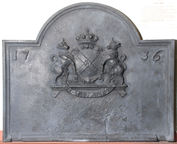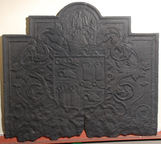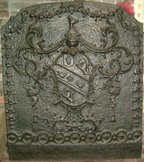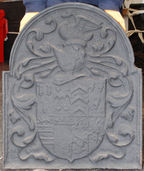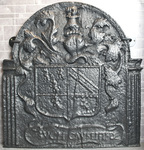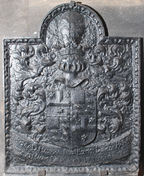-
392
Description: Arched rectangular shape; cavetto moulding on all sides, with short gaps at each end of the base (possibly to accommodate firedogs); date in top corners; shield, supporters, coronet and motto of the Barony of Bergavenny: Gules, on a saltire argent, a rose of the field, barbed and seeded proper. The motto, ‘Ne vile velis’ (Wish nothing base) is a pun on the family name.
Notes: The arms are those of William Nevill, 16th Baron Bergavenny, of Kidbrooke Park, Forest Row, Sussex. The date of the fireback coincides with the completion of the mansion. Formerly part of the J. H. Every collection.
Copies of this fireback are known.
Inscription: 1736 / NE VILE VELIS
Arms: William Nevill, 16th Baron Bergavenny
- Decoration tags:
- rectangular with round arch (shape)
- cavetto (edging)
- whole carved pattern
- individual numbers
- armorial
- text
Manufactured: in 1736 in the Weald area of England.
Current location: Anne of Cleves House, Southover High Street, Lewes, East Sussex, England.
Museum number: 1944.24.086 (part of the Sussex Archaeological Society museum group)
Citation: Hughes, G. B., 21 Apr 1955, 'Old English Firebacks', Country Life, 117, pp. 1056-60.
- Attached to series:
- Bergavenny firebacks
- Personal armorial firebacks
-
394
Description: Rectangular, with arched rectangular extension on top; double astragal edging (top & sides); shield, helmet, crest and mantling of the Pelham family: quarterly, 1st and 4th, Azure, three pelicans vulning themselves proper; 2nd and 3rd, Gules, two broken belts palewise the buckles upwards argent; the crest: a peacock in pride argent.
Notes: The arms may be those of Sir Nicholas Pelham (1517-59) or of one of his two sons, Sir John (d. 1580) or Sir Thomas (c1540-1624); the latter was created a Baronet in 1611. As there is no evidence of the augmentation of a baronet on the arms, the fireback probably predates the creation of the baronetcy. Formerly part of the J. H. Every collection.
Copies of this fireback are known.
Arms: Sir Nicholas, Sir John or Sir Thomas Pelham
- Decoration tags:
- rectangular with round arch (shape)
- double astragal (edging)
- whole carved pattern
- armorial
Manufactured: in the early-17th century possibly at Waldron Furnace in the Weald area of England.
Current location: Anne of Cleves House, Southover High Street, Lewes, East Sussex, England.
Museum number: 1944.24.054 (part of the Sussex Archaeological Society museum group)
- Attached to series:
- Pelham family firebacks
- Personal armorial firebacks
- Low relief armorial series
-
428
Description: Rectangular, with low curved top and stepped concave corners; suspended floral-chain border on top and sides; alternate small and large rings along the bottom; plain panel at base. Arms of Webster, baronet, of Battle: Azure, on a bend argent, cotised Or, between two demi-lions ermine, a rose gules, barbed and seeded proper, between two boars’ heads couped sable.
Notes: Sir Thomas Webster was created baronet in 1703; he was succeeded by his son, Whistler, in 1750. A pair of matching, cast-iron side plates form a set with this fireback.
Copies of this fireback are known.
Arms: Webster of Battle
- Decoration tags:
- rectangular with canted top corners and round arch (shape)
- none (edging)
- whole carved pattern
- armorial
Manufactured: in the early-18th century possibly at Robertsbridge Furnace, Salehurst in the Weald area of England.
Current location: Barbican House, High Street, Lewes, East Sussex, England.
Museum number: 39.52/LH000.986 (part of the Sussex Archaeological Society museum group)
- Attached to series:
- Personal armorial firebacks
-
454
Description: Arched rectangular shape; rebated fillet edging; shield, helm, crest and mantling of the family of Barttelot of Stopham, Sussex.
Notes: The shield is divided into eight quarters (from left) top: Barttelot, Stopham, Lewknor, Doyley; bottom: Tregoz, Camoys, Walton and Sykeston; arms granted in this form in 1616. Walter Bartlett/Barttelot ran Pallingham furnace in the early 17th century, suggesting a possible place of manufacture.
Copies of this fireback are known.
Arms: Barttelot of Stopham
- Decoration tags:
- rectangular with round arch (shape)
- rebated fillet (edging)
- whole carved pattern
- armorial
Manufactured: in the early-17th century possibly at Pallingham Furnace, Wisborough Green in the Weald area of England.
Current location: Hall Place, Bexley, Kent, England.
Museum number: 1931.21.005 (part of the Sussex Archaeological Society museum group)
- Attached to series:
- Personal armorial firebacks
-
462
Description: Rectangular with an arched rectangular style arch linked by symmetrical concave curves; ovolo moulding (top and sides); shield, helmet, crest and mantling of the family of Baker, of Mayfield, quartered with Farnden, of Sedlescombe: Quarterly, 1st and 4th, Argent, a tower between three keys erect sable (Baker); 2nd and 3rd, Purpure, a chevron vairy Or and gules, between three leopards’ faces Or (Farnden); crest (Baker): on a tower sable an arm embowed in mail holding in the hand a flint-stone proper. Date split by mantling.
Notes: A carved armorial on a plain, edged base board. John Baker (1644-1723) married Ruth, daughter and co-heiress of Peter Farnden, in 1663; she died in 1691. During their marriage the Farnden arms, would have been borne as an escutcheon of pretence in the centre of the arms of Baker, and not quartered with those of her husband until after her death. The date, 1690, is therefore spurious and would have been added to a later copy of a mid-18th century armorial fireback (see no. 16).
Inscription: 16 90
Arms: Baker of Mayfield quartering Farnden of Sedlescombe
- Decoration tags:
- rectangular with canted top corners and round arch (shape)
- ovolo (edging)
- carved pattern panels
- individual numbers
- armorial
- text
Manufactured: in the 19th century in the Weald area of England.
Current location: Barbican House, High Street, Lewes, East Sussex, England.
(part of the Sussex Archaeological Society museum group)
- Attached to series:
- Ironmasters armorial series
- Personal armorial firebacks
-
1272
Description: Arched rectangular shape with side pilasters; cavetto-moulded edging to the arch; quartered shield with an, off-centre, knight's helm, wreath and mantling, and crest of a cubit arm vested, or habited, cuffed and erased holding an arrow in bend sinister; the shield has, in the 1st quarter three lions rampant, in the 2nd a bend cotised, in the 3rd possibly a lion rampant, and in the 4th possibly a dragon rampant within a bordure indented; motto below the shield.
Notes: From the style of the mantling the pattern carver may have also been responsible for other firebacks from the west Midlands or Welsh border area.
Copies of this fireback are known.
Inscription: SVCH CAVSE I FIND
Arms: Not known
- Decoration tags:
- rectangular with round arch (shape)
- cavetto (edging)
- whole carved pattern
- heraldic
- armorial
- text
Manufactured: in the early- to mid-17th century in England.
Current location: Littlehampton Museum, Manor Road, Littlehampton, West Sussex, England.
Museum number: A263 (part of the Littlehampton Museum museum group)
- Attached to series:
- Herefordshire armorial series
- Personal armorial firebacks
-
975
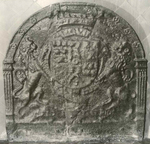 ? x ? mmImage subject to copyright
? x ? mmImage subject to copyrightDescription: Arched shape; double-fillet edged arched border, with six evenly-spaced roses, resting on pilasters; shield, supporters, garter and coronet of the Earl of Exeter; plain rectangular bottom panel.
Notes: The arms are of the earldom of Exeter, which was created in 1605 for Thomas Cecil, 2nd Lord Burghley (1542-1623).
Inscription: HONY SOIT QVI MAL Y PENSE [illegible]
Arms: Cecil, Earls of Exeter
- Decoration tags:
- rounded arched (shape)
- fillet (edging)
- whole carved pattern
- armorial
Manufactured: in the early-17th century in Wales.
Current location: Plas Llanmihangel, Llanmihangel, Glamorgan, Wales.
Museum number: GL 7628 (part of the National Monuments Record of Wales museum group)
- Attached to series:
- Personal armorial firebacks
-
1060
 ? x ? mm
? x ? mmDescription: Central shield bearing a lion rampant reguardant, with esquire's helm and crest of a seated hawk, surrounded by foliage and tasselled ribbons; twisted rope edging at each side; the shape of the fireback is dictated by the decorative elements; initials split by shield, the date similarly split below the initials.
Notes: Drawing of a fireback from old premises, formerly a baker's, opposite 20 Love Lane (later known as Lovat Lane), which ran between Eastcheap and Lower Thames Street; the arms appear to be those of the Morrice family (blazon: gules, a lion rampant reguardant or). Drawn by Charles Raymond Booth Barrett, 1891. A fireback of unique design.
Inscription: W M / 15 86
Arms: Morrice or Maurice
- Decoration tags:
- complex individual (shape)
- complex individual (edging)
- whole carved pattern
- heraldic
- armorial
- text
- plants
Manufactured: in 1586 possibly in the Weald area of England.
Current location: not known.
Museum number: SC/GL/PR/370/LOV/1/q7706298 (part of the London Metropolitan Archives museum group)
Citation: Windyer Morris, G. T., 4 Oct 1902, 'Arms on Fireback', Notes and Queries, 9th series, 10, p. 278.
- Attached to series:
- Miscellaneous pattern firebacks
- Personal armorial firebacks
-
870
Description: Arched rectangular shape with ovolo-moulded edging and narrow extensions to sides; central shield bearing arms with lion rampant supporters and motto scroll beneath; above, a marquesal coronet; date split between top corners; inserted initials above coronet; on top of arch, two downward facing dolphins with tails entwined.
Notes: The arms are of the family of Henry Pierrepont, marquess of Dorchester and earl of Kingston-upon-Hull, of Thoresby Hall, Nottinghamshire (blazon: argent semi of cinquefoils gules, a lion rampant sable), with the motto: Pie Repone Te (Place yourself piously), a pun on the name, Pierrepont. Confusingly, the marquisate of Dorchester was created twice for members of the same family. In 1645 it was created for Henry Pierrepont, 2nd earl of Kingston-upon-Hull, becoming extinct on his death without surviving male issue in 1680. It was created again for Evelyn Pierrepont, the 5th earl of Kingston in 1706 who was subsequently elevated to the dukedom of Kingston in 1715. The original casting may therefore have dated to between 1645 and 1680 or between 1706 and 1715. The initials may be related to the Halls, the 2nd Duke of Kingston's mother's family, and were probably added with the date in 1728. Woolley & Wallis auction, Salisbury, 8 Jul 2014, lot 518 (£250); Lyon and Turnbull auction, Edinburgh, 1 Sep 2021, lot 10.
Copies of this fireback are known.
Inscription: A H / 17 28 / PIE REPONE TE
Arms: Pierrepont, Marquess of Dorchester
- Decoration tags:
- rectangular with round arch (shape)
- ovolo (edging)
- whole carved pattern
- individual letters
- armorial
- text
Manufactured: in 1728 in England.
Current location: not known.
- Attached to series:
- Personal armorial firebacks
- Pierrepont series
-
480
Description: Arched rectangle; ovolo, egg-and-dart moulded edging; shield, helm, coronet, crest and mantling; curved inscription panel below shield.
Notes: The heraldic devices on the shield, and the form of the helm and crest suggest this may be a continental achievement of arms; the style of the fireback is, however, is more characteristic of English types.
Copies of this fireback are known.
Inscription: ... D HADRIANI ... EQVITE DOM DE HE.. / ... M.. ... ... [?]
Arms: not known
- Decoration tags:
- rectangular with round arch (shape)
- egg and dart (edging)
- whole carved pattern
- planklines
- armorial
- text
Manufactured: in the early-17th century .
Current location: Maidstone Museum, St Faith's Street, Maidstone, Kent, England.
(part of the Maidstone Museum museum group)
- Attached to series:
- Personal armorial firebacks
